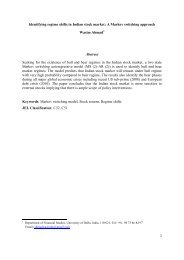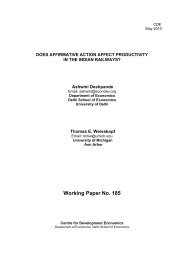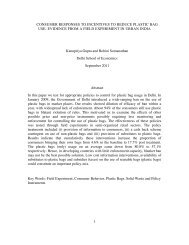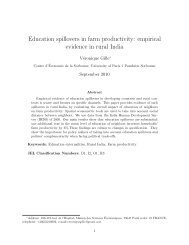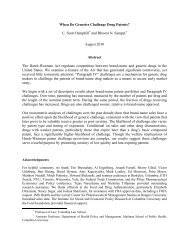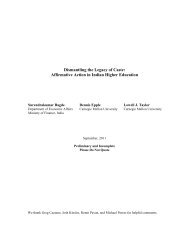Stochastic Dynamic Models for Political Regime Change and ...
Stochastic Dynamic Models for Political Regime Change and ...
Stochastic Dynamic Models for Political Regime Change and ...
Create successful ePaper yourself
Turn your PDF publications into a flip-book with our unique Google optimized e-Paper software.
1 Introduction<br />
In general, an improvement in political conditions will lead to faster <strong>and</strong> sustained growth. In<br />
this scenario of politically enhanced growth, the effects of political institutions on growth may<br />
persist over a long period of time (Barro 1997). For example, when a nation increases its<br />
level of economic freedom from a minimal to a maximal level as the result of political change,<br />
tremendous room will be created <strong>for</strong> long-run economic growth. The long-run growth rate of a<br />
country is determined also by politics, along with economic behavior <strong>and</strong> demographic trends.<br />
There is indeed a school of thought that political markets are inherently inefficient <strong>and</strong><br />
competition among the players causes excessive rent-seeking activity (Tullock 1967, 1983,<br />
1989; McCormick et al. 1984). The existing literature, in the context of trade policy, also<br />
argues that competitive rent-seeking results in an efficiency loss to the economy (Krueger 1974,<br />
Bhagwati 1982, Grossman <strong>and</strong> Helpman 1994). Lab<strong>and</strong> <strong>and</strong> Sophocleus (1992), <strong>for</strong><br />
instance, estimate that rent seeking in allocating transfers cost the US at least one-fourth of<br />
its GDP in 1985. Also growth of government debt is positively related to the frequency of<br />
government change De Haan <strong>and</strong> Strum 1994. Persson <strong>and</strong> Svensson (1989) have shown<br />
that a conservative government, which favors a low level of government spending but knows that<br />
it will probably be replaced by a government in favour of higher spending levels, will borrow<br />
more than when it was certain to stay in office. In this context see also Alesina <strong>and</strong> Perotti<br />
1996, Volkerink <strong>and</strong> De Haan 1999, Perotti <strong>and</strong> Kontopoulos 2002. Uppal (2009),<br />
examines the effect of legislative turnover on government expenditures in a panel of 15 Indian<br />
states during 1980-2000. He finds that political turnover promotes government expenditure (his<br />
results are ribust with respect to alternative specifications of per capita or as percentage of<br />
GDP). De Haan <strong>and</strong> Strum 1994 have examined whether the number of government changes<br />
may help explain cross-country differences in public debt growth. It is very interesting that the<br />
frequency of government changes apparently does matter. This result is broadly in accordance<br />
with the conclusions of Grilli, Masci<strong>and</strong>aro <strong>and</strong> Tabellini, (1991). Jong-A-Pin <strong>and</strong><br />
De Haan (2007) finds that economic growth accelerations are preceded by economic re<strong>for</strong>ms.<br />
Furthermore, they find that growth accelerations are more likely to happen after the start of<br />
a new political regime. The dataset used by them consists of 106 countries over the period<br />
1957-1993 of which 57 countries experienced at least one growth acceleration. More specifically,<br />
the findings are that the effect of economic re<strong>for</strong>m on the probability of a growth acceleration is<br />
highly significant in all specifications. However, the results <strong>for</strong> political regime changes are less<br />
clear. <strong>Political</strong> regime changes are in general not related to growth accelerations, but there is a<br />
negative <strong>and</strong> significant effect of regime duration <strong>for</strong> all specifications. This implies that growth<br />
accelerations are more likely to happen after the start of a new political regime. For a survey<br />
on the relationship between economic growth <strong>and</strong> political regimes see Przeworski, Alvarez,<br />
Cheibub <strong>and</strong> Limongi (2000).<br />
But there is also a counter literature, <strong>for</strong> instance in the development literature, that asserts<br />
the concept of antagonistic growth, which refers to a situation where democratic governments<br />
1



